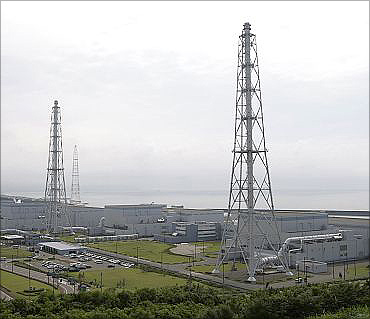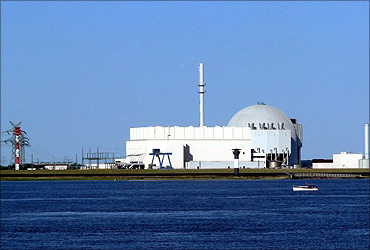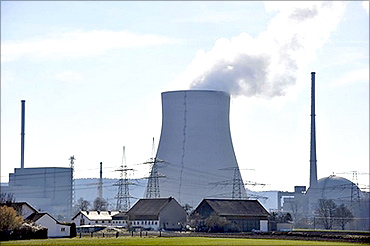Photographs: Reuters
Although the era of nuclear energy began in 1942, it was only in the 1950s that commercial nuclear power stations started operation.
Today, there are more than 440 commercial nuclear power reactors operating in 30 countries, with 377,000 MWe (megawatts electrical) of total capacity, providing about 14 per cent of the world's electricity.
Around 56 countries operate a total of 250 research reactors and 180 nuclear reactors power about 140 ships and submarines.
Here is a look at five biggest nuclear reactors in the world based on their electricity generation capacity.
...
Five biggest nuclear reactors in the world
Image: Kashiwazaki-Kariwa provides electricity to 16 million houses.Photographs: Reuters
Japan's Kashiwazaki-Kariwa reactors are not big enough individually to break any records, but their combined output puts them on top of the ranking.
The plant, which was completed in 1997, has seven reactors, with a combined electrical output of 8,212 megawatts.
That is enough to provide electricity to more than 16 million Japanese households each year.
...
Five biggest nuclear reactors in the world
Image: Chooz B1 and B2 generate five per cent of France's energy needs.Photographs: Reuters
2: Chooz B1 and 2: 1,500 MWe
France's nuclear reactor Chooz A went out of operation in 1991 after 22 years of electricity generation, but Chooz B1 and Chooz B2 continue to be in operation.
Although the reactors were originally designed to generate 1,450 megawatts of electricity, the output was later upgraded to 1,500 megawatts.
With such a massive output, Chooz B1 and 2 are easily one of the biggest reactors in the world, generating more than 5 percent of France's total nuclear power.
...
Five biggest nuclear reactors in the world
Image: Civaux 1 and Civaux 2 cost $4.1 billion to construct.Photographs: Reuters
3: Civaux 1 and 2: 1,495 MWe
France has 59 nuclear reactors producing 76 per cent of France's total electricity requirements, and two reactors located in the city of Civaux are among the biggest in the country.
Civaux 1 and Civaux 2, which cost about $4.1 billion to build, became fully operational in 1999.
Turbines weigh about 3,000 tonnes and are more than half a football field in length, which shows how Civaux reactors are able to produce 1,495 megawatts of electricity.
...
Five biggest nuclear reactors in the world
Image: Brokdorf reactor is the biggest in Germany.Photographs: Reuters
4. Brokdorf: 1,410 MWe
The Brokdorf reactor, located near the municipality of Brokdorf in Germany, stores more than 110 tonnes of uranium.
When the construction began on the plant in 1981, there were huge protests by anti-nuclear groups, but by 1986, the plant was fully operating.
In terms of output, it was the world leader in 1992 and 2005.
It is currently producing 1,410 megawatts of electricity, but it can once again become the world leader before its scheduled decommissioning in 2018.
It is Germany's largest reactor and one of the largest in the world.
...
Five biggest nuclear reactors in the world
Image: Isar I and Isar II power 1.5 million households.Photographs: Reuters
5: Isar II: 1,400 MWe
Although nuclear power provides 20 per cent of Germany's electricity requirements, concerns over safety and waste storage have forced the government to shut down many reactors.
Isar I and 11, located in the Bavaria region, are also scheduled to be decommissioned. Both reactors provide electricity to more than 1.5 million households each year.
Isar II, which was commissioned in 1988, has a total capacity of 1,400 megawatts.








article